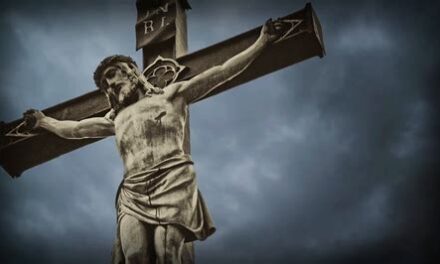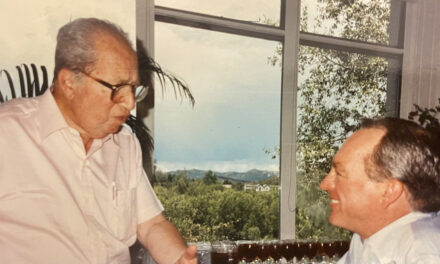On May 25, 2023, Westminster Bridge, London, hosted a procession it had never seen before. A group, more properly a convent, of nuns traveled across the bridge on Vespas, led by Lorna Watson on a red model with a matching sidecar. In case you don’t know who Miss Watson is, she plays Sister Boniface in the eponymous mysteries that began on BritBox in 2022. The series remains in production with a fourth season on the way.
As for Sister Boniface, she’s a nun and a sleuth who first appeared in “The Bride of Christ,” episode six, season one of Father Brown in 2013. (As fans of the Father Brown stories will know, Chesterton never dreamed of the character.) That was nine years before the bespectacled nun got her own show.
Now, my impression of spin-offs remains fixed: one show gives birth to another when a regular but subsidiary character becomes so popular that the show’s producer can’t resist plotting a new show around that character. Consider The Mary Tyler Moore Show’s Rhoda or, more recently, Better Call Saul.
So, of course, that’s how Sister B. became the star of her own series. Not quite. If one excludes “The Forensic Nun” (season 11, episode 2 of Father Brown), which aired in 2024, two years after the Sister Boniface Mysteries premiered, then “The Bride of Christ” was her one and only appearance in Father Brown. Hardly the stuff to inspire a new show, unless she had a spectacular debut. To find out, I decided to watch it. Spectacular it isn’t, but it’s enjoyable. Whether its virtues depend on Lorna Watson’s portrayal of Sister B. or Mark Williams’ Father Brown may be a matter of either taste or literacy. For Chesterton purists (that is, people who have read the stories), Williams may be acceptable but not nearly Catholic enough. As for Sister B., since reading GKC has nothing to do with her portrayal, her effectiveness must depend on acting and screenwriting.
So, how does she measure up? First, she has eccentricity written all over her, and why not? Peering from her habit, her face, accented with round, brown glasses, appears owlish. Her voice hits a rather high pitch, but, for sure, it’s distinctive. And she rides a Vespa. Her strength is chemistry, which viewers may remember from her first appearance. In “The Bride of Christ,” where her skills found a convenient outlet in the convent’s winery, she seemed competent enough. In “Unnatural Causes,” the first episode of her own show, her abilities have blossomed so dramatically that she’s become the preferred authority on things murderously chemical for Detective Inspector Sam Gillespie (Max Brown).
As one may easily guess, D.I. Gillespie needs her because a young woman, Grace Pearson (Danielle Phillips), has been strangled at a local fair. She had grown up as housemaid for the rich Bellamy family and as close friend to Electra Bellamy (Silvia Presente), now a classics scholar. Silvia taught Grace to read when they were growing up. Did Grace pick up a smattering of Greek too? In addition, Electra and her brother Edwin (Michael Marcus) are in mourning for their deceased uncle who appears to have been a real tyrant. Death by natural causes? If not, the perennial question of whodunnit develops into a double-whodunnit. Gillespie, Sister Boniface, and D. S. Felix Livingston (Jerry Iwu) must combine their talents to unmask the criminal.
D. S. Livingston has arrived just before the discovery of the body, and in fact was misdirected to the village. He was seconded from an African constabulary to the London Metropolitan Police and wants to get there as soon as possible. However, London will have none of it; he can stay put as far as they’re concerned.
The plot, paced generally well, raises the usual questions. The chief riddle about Grace Pearson is obvious, but what about the tyrannical uncle? He dropped dead at the dinner table of what looked like a heart attack. But was that the cause? Was he poisoned? Are the siblings, who had no great love for him, guilty? Are the two deaths connected? It’s all sufficiently intriguing to satisfy a mystery lover.
Still, the episode has some peculiar problems. For one thing, the action rushes from scene to scene a bit too quickly, leaving the impression that it’s somewhat contrived. Second, the characters, Sister Boniface included, have only surface interest. Sister B. possesses neither the native genius nor the deep religiosity that make Father Brown—especially as Chesterton conceived him—so fascinating. Brown, like Agatha’s Christies’ Miss Marple, could be brilliant behind a façade of insignificance; Sister B., eccentricities notwithstanding, just doesn’t shine brightly enough. Both Gillespie and Livingston appear too nonchalant in their pursuit of crime; this is murder, after all. One almost yearns for some genuine friction among the three to create more drama, but it’s just not there.
The Sister Boniface Mysteries offer pleasant fare although it’s a cut below the Father Brown series. I’ll watch more of it and, I suspect, enjoy it. But, all told, it’s more like a snack than a banquet. And it certainly isn’t the Eucharist.














